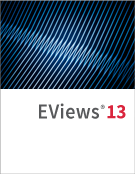
"…Use EViews Enterprise to improve your modeling accuracy and work efficiency by connecting directly to your vendor's most recent data"
EViews Enterprise Database Extensions (EDX)
Background
Traditionally, EViews users could only open a handful of EViews supported foreign database formats (such as DataStream, EcoWin, Haver, FRED, etc.) directly within EViews. If your data resided in an unsupported database format, you were limited to using ODBC (if an ODBC driver was available) or using an intermediate file format (such as XLS, CSV or HTML) or the Windows clipboard to exchange data. There are several limitations to this approach:
- Working with generic formats such as text and Excel files can be complicated since these formats are not self-describing so that additional information about the structure of the files may be needed for EViews to understand the files.
- Frequency information must be inferred by EViews from date identifiers accompanying the data and this is not always reliable.
- There is no way to communicate additional attributes along with the observation values such as source, units, etc.
- Data brought into EViews this way cannot be “linked” back to the source to allow for automatic refreshes when a workfile is loaded. (Data can only be updated by rerunning an EViews program to manually perform the refresh.)
Extending EViews Databases
In an effort to provide EViews with access to as broad a range of data sources as possible, we have created a new Database Extension Interface. Now, any external data source that implements this interface can be opened directly from within EViews and used just like an EViews database.
By implementing a database extension for an external database format, you can extend EViews to include one or more of the following functionalities:
- an EViews user can ask what objects the external database contains.
- an EViews user can read data objects from the external database.
- an EViews user can write data objects to the external database.
- an EViews user can browse through the contents of the external database using a custom graphical interface developed specifically for the data source.
The Database Extension Interface is a set of COM interfaces. Supporting a new format involves creating a small library (usually housed in a DLL) that contains COM objects that implement these interfaces. The library can be developed in many different programming environments including native C++ and Microsoft .NET. These COM objects are used by EViews to interact with the underlying database.
Further reading and examples
To read more about EViews EDX, download the EDX whitepaper.
EDX Example projects may also be downloaded.